Memory Frequency Scaling in SFF Systems: An Investigation with SO-DIMMs and Coffee Lake
by Ganesh T S on November 28, 2018 8:00 AM ESTMiscellaneous Performance Metrics
This section looks at some of the other commonly used benchmarks representative of the performance of specific real-world applications.
3D Rendering - CINEBENCH R15
We use CINEBENCH R15 for 3D rendering evaluation. The program provides three benchmark modes - OpenGL, single threaded and multi-threaded. Evaluation of different PC configurations in all three modes provided us the following results.
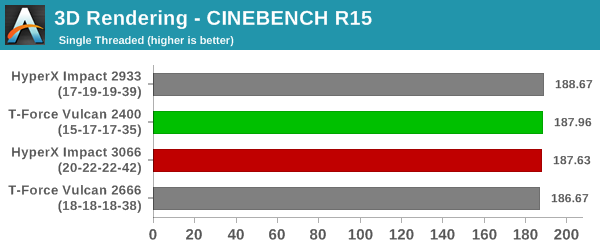
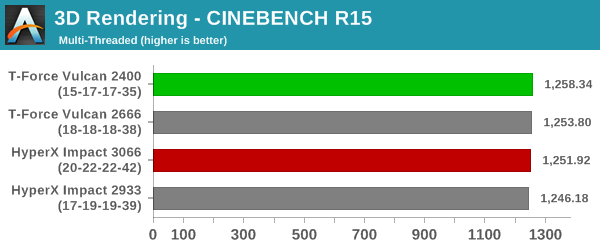

This benchmark is generally CPU-limited, and we do not see any significant benefit from moving to the higher speed grades, at least within the set of configurations that we tested.
x265 Benchmark
Next up, we have some video encoding benchmarks using x265 v2.8. The appropriate encoder executable is chosen based on the supported CPU features. In the first case, we encode 600 1080p YUV 4:2:0 frames into a 1080p30 HEVC Main-profile compatible video stream at 1 Mbps and record the average number of frames encoded per second.
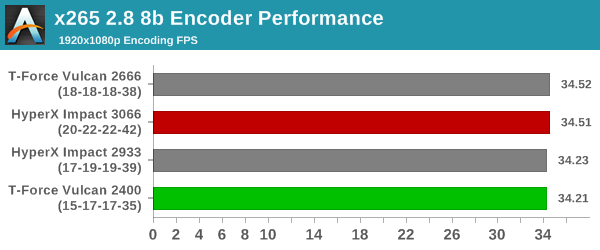
Our second test case is 1200 4K YUV 4:2:0 frames getting encoded into a 4Kp60 HEVC Main10-profile video stream at 35 Mbps. The encoding FPS is recorded.
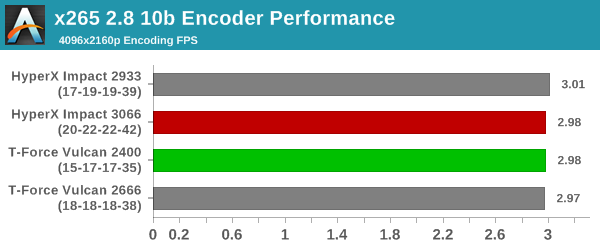
x265 is again a CPU-limited benchmark, and the memory speeds have negligible impact on the performance for our benchmarking encoding operations.
7-Zip
7-Zip is a very effective and efficient compression program, often beating out OpenCL accelerated commercial programs in benchmarks even while using just the CPU power. 7-Zip has a benchmarking program that provides tons of details regarding the underlying CPU's efficiency. In this subsection, we are interested in the compression and decompression rates when utilizing all the available threads for the LZMA algorithm.
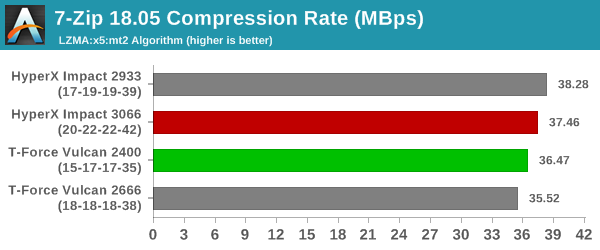
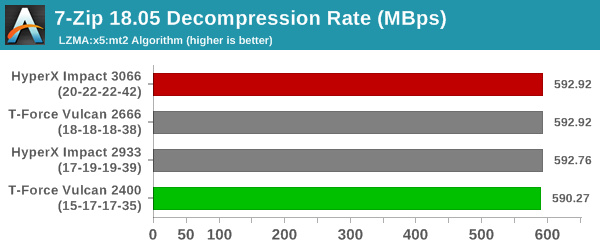
The 7-Zip compression benchmark is probably the best real-world representative of what a good DRAM configuration can deliver. The compression rate is highly dependent on the memory latency, and we see that the DDR4-2933 configuration (that had the best latency numbers in the AIDA64 Cache and Benchmarks testing) comes out on top. Decompression is CPU-limited, and the memory speeds don't impact it much.
Cryptography Benchmarks
Cryptography has become an indispensable part of our interaction with computing systems. Almost all modern systems have some sort of hardware-acceleration for making cryptographic operations faster and more power efficient. In this sub-section, we look at two different real-world applications that may make use of this acceleration.
BitLocker is a Windows features that encrypts entire disk volumes. While drives that offer encryption capabilities are dealt with using that feature, most legacy systems and external drives have to use the host system implementation. Windows has no direct benchmark for BitLocker. However, we cooked up a BitLocker operation sequence to determine the adeptness of the system at handling BitLocker operations. We start off with a 2.5GB RAM drive in which a 2GB VHD (virtual hard disk) is created. This VHD is then mounted, and BitLocker is enabled on the volume. Once the BitLocker encryption process gets done, BitLocker is disabled. This triggers a decryption process. The times taken to complete the encryption and decryption are recorded. This process is repeated 25 times, and the average of the last 20 iterations is graphed below.
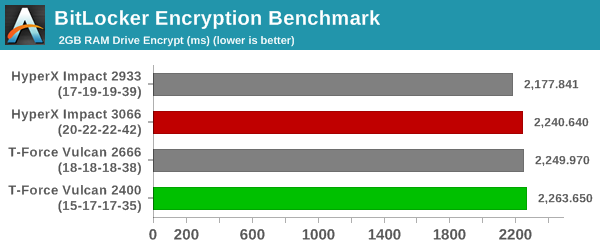
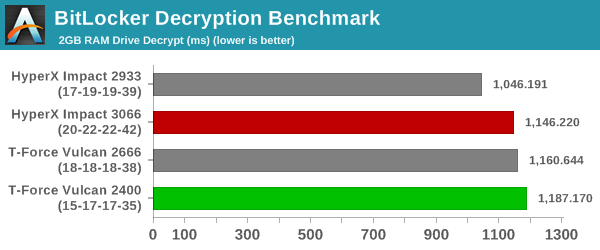
Due to the use of a RAM drive in this benchmark, the usually CPU-speed limited cryptographic operations of BitLocker seem to favor the DDR-2933 configuration. We move on to a couple of other benchmarks to see if the RAM drive is indeed the cause for the significant gulf seen in the above graphs.
Creation of secure archives is best done through the use of AES-256 as the encryption method while password protecting ZIP files. We re-use the benchmark mode of 7-Zip to determine the AES256-CBC encryption and decryption rates using pure software as well as AES-NI. Note that the 7-Zip benchmark uses a 48KB buffer for this purpose.
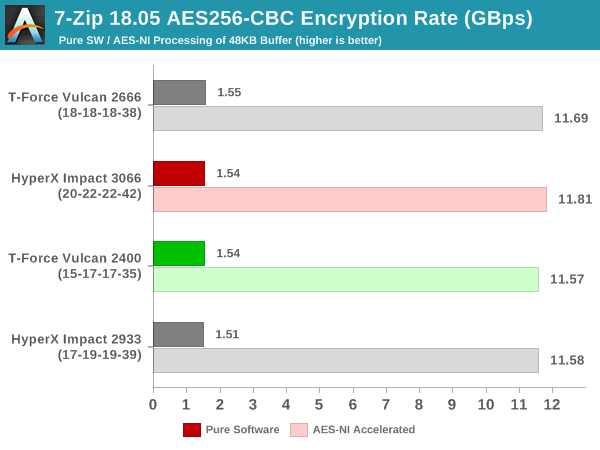
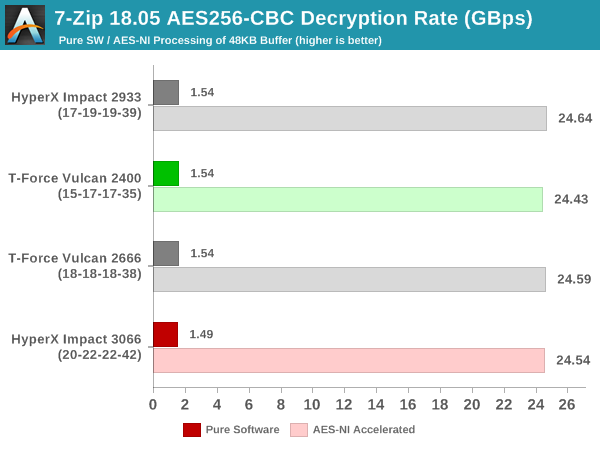
Once the data is in the CPU cache, we see that the RAM has no impact on the cryptography operations.
Yet another cryptography application is secure network communication. OpenSSL can take advantage of the acceleration provided by the host system to make operations faster. It also has a benchmark mode that can use varying buffer sizes. We recorded the processing rate for a 8KB buffer using the hardware-accelerated AES256-CBC-HAC-SHA1 feature.
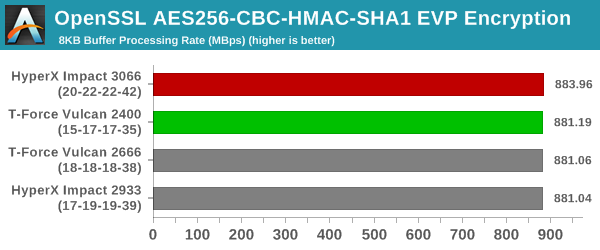
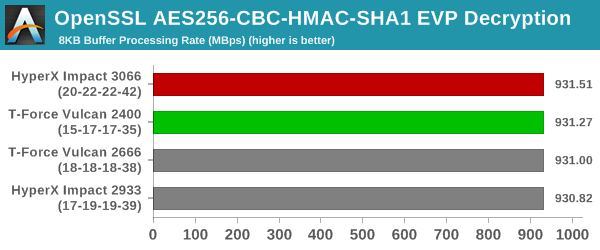
As expected, this benchmark also shows that there is nothing to gain in performance by moving to SO-DIMMs with better speeds or timing characteristics.
Agisoft Photoscan
Agisoft PhotoScan is a commercial program that converts 2D images into 3D point maps, meshes and textures. The program designers sent us a command line version in order to evaluate the efficiency of various systems that go under our review scanner. The command line version has two benchmark modes, one using the CPU and the other using both the CPU and GPU (via OpenCL). We present the results from our evaluation using the CPU mode only. The benchmark (v1.3) takes 84 photographs and does four stages of computation:
- Stage 1: Align Photographs (capable of OpenCL acceleration)
- Stage 2: Build Point Cloud (capable of OpenCL acceleration)
- Stage 3: Build Mesh
- Stage 4: Build Textures
We record the time taken for each stage. Since various elements of the software are single threaded, and others multithreaded, it is interesting to record the effects of CPU generations, speeds, number of cores, and DRAM parameters using this software.
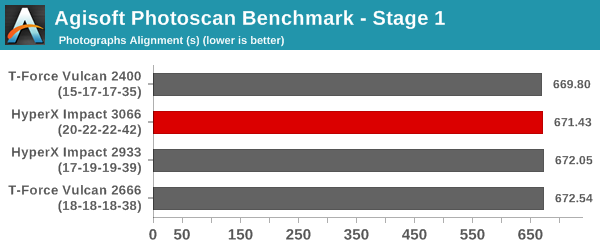
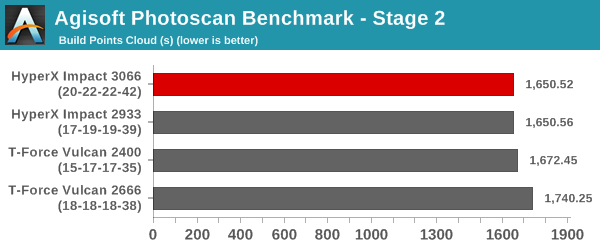
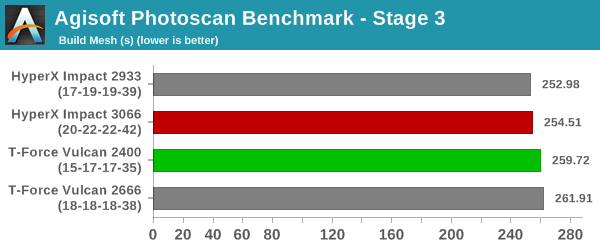
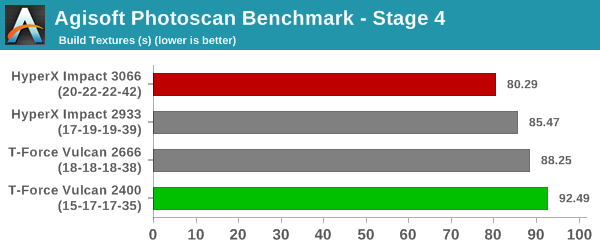
The raw bandwidth provided by the DDR4-3066 configuration seems to work well for the Agisoft Photoscan workload. The latency doesn't seem to be much of a factor.
Dolphin Emulator
Wrapping up our application benchmark numbers is the new Dolphin Emulator (v5) benchmark mode results. This is again a test of the CPU capabilities.

The memory characteristics don't seem to affect the benchmark much, though we see the DDR4-2933 configuration coming up with the best performance.










25 Comments
View All Comments
BedfordTim - Wednesday, November 28, 2018 - link
It would have been interesting to see some bargain basement memory in the comparison. Is there a specification below which we start to see a difference?goatfajitas - Wednesday, November 28, 2018 - link
I dunno, I think it gets the job done. The takeaway is the same as it has been for a decade... Higher bandwidth memory with higher latency provides very little actual performance improvements.qlum - Wednesday, November 28, 2018 - link
To add some qualifiers to what you said:In regards to cpu performance
on intel's core achitecture
IGP performance, AMD, certain memory limited workloads tell a different story.
goatfajitas - Wednesday, November 28, 2018 - link
"on intel's core achitecture"Agreed.
Flunk - Wednesday, November 28, 2018 - link
No, not really. The slowest and faster RAM here aren't that far off. What it really tells us is that minimal increases in RAM performance can bring noticeable performance improvements but only in memory-heavy applications. Which is pretty much exactly what you'd expect.goatfajitas - Wednesday, November 28, 2018 - link
"No, not really. The slowest and faster RAM here aren't that far off."That is what I said. Barely noticeable even in synthetic benchmarks.
BedfordTim - Wednesday, November 28, 2018 - link
There is a difference in two memory heavy applications. The RAM drive shows a ~20% benefit and one of the image processing benchmarks shows ~10% benefit.There will be a tiny number of people doing very specific applications who might notice the difference.
peterfares - Wednesday, November 28, 2018 - link
Not sure what other games it applies to but in Overwatch the RAM speed actually has a pretty significant impact on FPS when you start going very high FPS.https://www.reddit.com/r/Overwatch/comments/9srhx5...
Not sure what what speed the benefits stop, but improvements were still easily seen at 3200MHz.
Death666Angel - Wednesday, November 28, 2018 - link
It just seems a bit weird to test those speeds. G.Skill RipJaws SoDIMM DDR4-3200 CL18-18-18-43 are available in 8GB form for the same price as regular DDR4-3200 RAM and the 16GB variant is only slight more expensive (would be 5th in the price ranking with regular DDR4-3200 RAM). Is that just a weird German price thing? I was even considering buying them with an adapter just so I can have some more potential usability for the future. :Ddeil - Wednesday, November 28, 2018 - link
IMHO small things that does not even make the cpu leave lower power state happens faster, page loading, folder browsing etc...might be just bias or simple "better timings" that was also the case for me. Still I feel something different in day-to-day stuff.